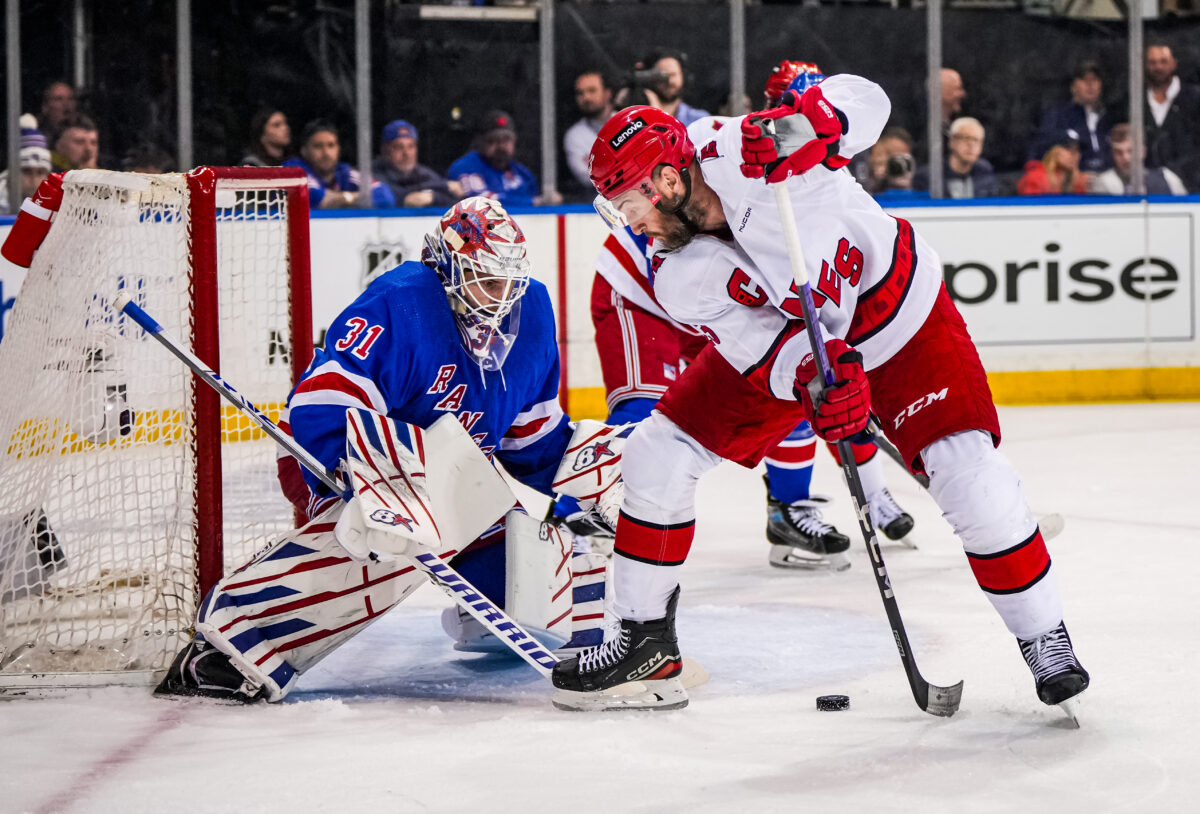Igor Shesterkin is arguably the most important piece to the New York Rangers’ franchise right now – but hockey has a business side that can’t be ignored.
Related: Matt Rempe Is Choosing a Dangerous Path to NHL Success
The Russian goaltender became first eligible to sign a contract extension with the team on July 1. For some, there might be some unease now that we are weeks past that date. Shesterkin, in five NHL seasons, won a Vezina Trophy and has carried his team through multiple playoff runs.
While last season was a down one for the 28-year-old, he is still one of the best goaltenders in the league. Shesterkin has saved more than 74 goals above expected in the past three seasons, according to Money Puck. Now, with the chance to become an unrestricted free agent in less than 12 months, the netminder can leverage that to get a huge payday.
Why the Rangers Shouldn’t Rush
While the clock is starting to tick, president and general manager Chris Drury can’t panic. He doesn’t need to get a deal tomorrow, it needs to happen before July 1, 2025, when Shesterkin would hit the open market.

The average annual value (AAV) will probably be the biggest obstacle in the next contract. If you look at some recent big goalie contracts, Sergei Bobrovsky scored a seven-year $70 million deal in 2019. Carey Price signed an eight-year $84 million contract in 2017, which at the time represented a monstrous 14 percent of the cap. If the demands are similar from Shesterkin’s camp, he could be seeking a contract as large as $12.88 million per season, which is based on a $92 million salary cap.
That number would complicate things for the Rangers, who will also need to save some cap space for Alexis Lafrenière‘s next contract. After Juraj Slafkovsky signed an eight-year, $60.8 million extension this summer, you would have to think the 2020 first-overall pick is in line for at least an $8 million AAV.
That could be $20 million against the cap just for two players. Drury shouldn’t be in a hurry to give Shesterkin $12 million-plus – unless he has to. It’s a lot of money to give to a goaltender, making it much harder to build a contending team in front of him.
How Drury Can Use Leverage
While losing Shesterkin would make things uncomfortable, it needs to be a negotiation. There’s no accepting the first asking price in July. And while the star goaltender could elect to go to free agency, Drury will have the upper hand in some scenarios.
One of them is the market – New York. There’s a reason why everyone wants to play there, from Wayne Gretzky to Artemi Panarin. Heck even Drury signed with the Rangers as a free agent back in 2007. Playing in one of the biggest cities in the world not only allows them to earn more money from endorsements, but also career opportunities for their spouses too. New York would be tough to leave behind for Shesterkin, who has a wife and a toddler son. Plus, the Original Six draw, along with the history, makes the Rangers that much more attractive.
Other than the bright lights of New York, the Rangers will have an advantage financially. Right now, they are the only franchise that can offer Shesterkin an eight-year deal. On the open market, the 2014 fourth-rounder can only get a max of seven years. This has been the case for free agents since the 2012-13 NHL Lockout came to an end. It gives teams with pending free agents a small advantage.
So if a team is willing to pay Shesterkin 7×12 for $84 million, the Rangers can get him at a $10.5 AAV for the same total cost – but over eight years. It’s one way of thinking of it. That might be the magic number to get a deal done before training camp, but can Drury get that cap number even lower by offering him a full or multi-year no-move clause? If the goal is to get the AAV as low as possible, then he might as well take a shot. By offering eight years, the Rangers hierarchy would already be committing to a life-long marriage. So maybe there’s wiggle room to get the number down to $9-$10 million a season.
Regardless, Shesterkin is going to get paid. It may not be today or before training camp, but he will. The question is if both sides can find a deal that makes themselves comfortable before next July. There’s plenty of time left to negotiate – and the Rangers do have some leverage. It’s not like reports have been circulating that Shesterkin is upset the two sides haven’t struck a deal yet. Drury still has plenty of time and needs to use it.
